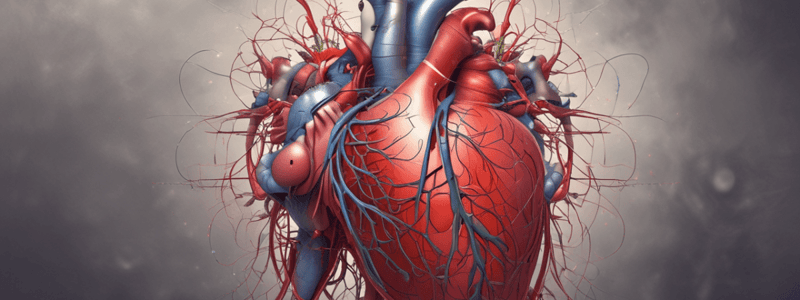Podcast
Questions and Answers
What is the typical end-diastolic volume of the left ventricle?
What is the typical end-diastolic volume of the left ventricle?
- 50 milliliters
- 125 milliliters (correct)
- 100 milliliters
- 250 milliliters
- 200 milliliters
Which event is associated with the first heart sound?
Which event is associated with the first heart sound?
- Closing of the A-V valves (correct)
- Inrushing of blood into the ventricles during diastole
- Opening of the A-V valves
- Beginning of diastole
- Closing of the aortic valve
What happens at the end of ventricular isovolumic relaxation?
What happens at the end of ventricular isovolumic relaxation?
- The A-V valves close (correct)
- The aortic valve opens
- The aortic valve closes
- The mitral valve opens
- The pulmonary valve closes
Sympathetic stimulation of the heart does which of the following?
Sympathetic stimulation of the heart does which of the following?
In which phase of the ventricular muscle action potential is the sodium permeability the highest?
In which phase of the ventricular muscle action potential is the sodium permeability the highest?
Franck-Starling's law of the heart
Franck-Starling's law of the heart
When the cell is in absolute refractory period, its excitability
When the cell is in absolute refractory period, its excitability
Which component mainly contributes to the colloid osmotic pressure?
Which component mainly contributes to the colloid osmotic pressure?
What function do vitamin B12 and folic acid perform that is critical to hematopoiesis?
What function do vitamin B12 and folic acid perform that is critical to hematopoiesis?
Flashcards are hidden until you start studying
Study Notes
Cardiac Physiology Quiz
Ventricular Function
- The typical end-diastolic volume of the left ventricle is around 125 milliliters.
- At the end of ventricular isovolumic relaxation, the mitral valve opens.
Heart Sounds
- The first heart sound is associated with the closing of the A-V valves.
Ventricular Muscle Action Potential
- Sodium permeability is highest during phase 0 of the ventricular muscle action potential.
Autonomic Nervous System
- Sympathetic stimulation of the heart releases norepinephrine at the sympathetic endings.
- This increases sinus nodal discharge rate, excitability, and cardiac contractility.
Franck-Starling's Law of the Heart
- Franck-Starling's law of the heart explains the increase in cardiac output that occurs when venous return is increased.
Cardiac Action Potential
- During the absolute refractory period, the cell's excitability is zero.
Blood
- Protein is the main component that contributes to the colloid osmotic pressure.
Hematopoiesis
- Vitamin B12 and folic acid are essential for hematopoiesis, as they support the synthesis of DNA and RNA in erythroid and myeloid cells.
Studying That Suits You
Use AI to generate personalized quizzes and flashcards to suit your learning preferences.



